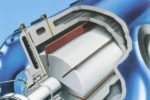Supercharger Type: Vane
Rotary vane superchargers are positive displacement compressors that were made popular in the 30’s. The design is best suited for smaller engines due to limited cavity space and lower RPM operations. The typical design is a cylindrical casing with a rotor that is off-center creating a crescent shaped cavity for the air or fluid to flow through. As the rotor turns the vanes (or blades), which may be fixed or sliding, trap and move the air through the crescent area to the outlet port. Shorrock, also known as Centric, superchargers, which were manufactured from the 30’s to 60’s, were a high quality, but expensive, compressor that used a more complex fixed vane design. The Shorrock connected the vanes to a trunnion shaft which ensured the blades were held about 1 thousandths of an inch away from the casing walls to prevent friction and wear. Another well known unit was a Judson sliding vane compressor which entered into the production market in the early 50’s. The blades in the Judson sit in slots in the rotor drum and are “thrown” outwards by centrifugal force. The vanes were made of a composite called Micarta which allows for a light contact of the inner housing wall but with less friction and heat creation than a harder metal vane. This design ensure there is a good seal between vanes (less air leakage) and is more cost effective and simple than fixed blade designs.

Cutaway of a Ro-Flo rotary sliding vane compressor. Ro-Flo vane compressors are used in the oil and gas industry.
Displacement Type: Dynamic Displacement
Compression Type: Internal Compression
Year Designed: 1874
Designed By: Charles C. Barnes